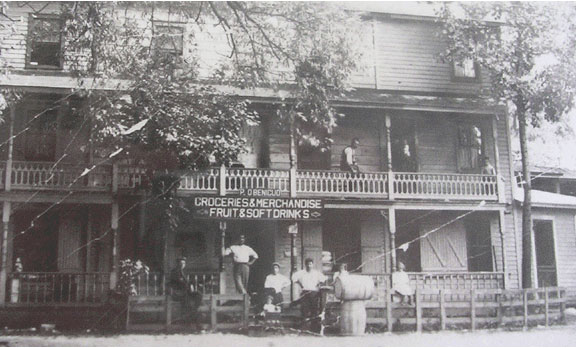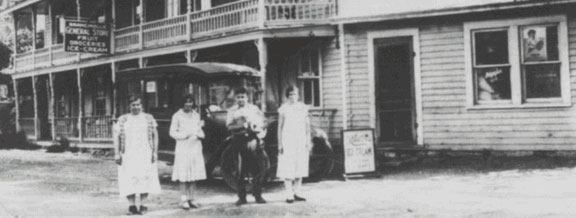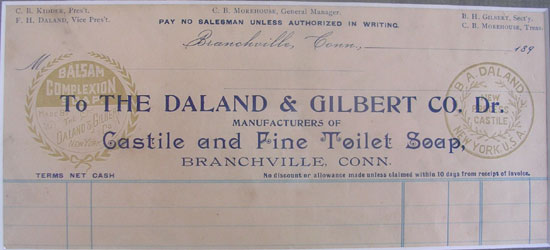|
Special
Thank you to Brian and Susan Sullivan for requesting this
research and Lucy Scala for her assistance and photographs.
The Ridgefield Historical Society and Jack Sanders also assisted
me in this research and I am very thankful to them as well.
14 West Branchville
Road (Formerly Old Main Highway, Old State Highway)
Building
History- Historic Commissions/Registries:
1979
Connecticut Historic Commission documentation has building
listed as:
1.
Victorian Commercial, Date of Construction c.1875. *Property
card at Ridgefield Town Hall notes main building as 1890+.
2.
Structure: Wood Frame, Post and Beam, Balloon; Roof: Gable.
*Exterior remodeled in 1979/1980: poured footings and drainage.
C.O. issued 2/18/1980.
3.
Notable Features: 2nd floor gallery not unlike the "raised
cottage" of the South, is a form peculiar/unique in this area;
Widely adorned posts, brackets and scroll saw balustrade survive;
Store area remains in 20th century form, notable to this reason.
*Interior floor plan changed/remodeled between 9/20 - 12/03/1985.
4.
Field evaluation notes: "In 1930's Benny's Bar & Restaurant
(B. Allegrasso)"; "Renovated as Art Gallery in 1980's" It
is presumed these were the renovations of 1985 to create what
was known as the SOHO Art Gallery.
August
12, 1982 building entered onto National Registry of Historic
Places as "The Branchville RR Tenement Building".
Building
Ownership:
1.
Pre-1907 Abijiha N. Fillow (farm building)
2.
Pasquale DeBenigno 1907 - 1942
3.
John DeBenigno 1942 - 1951
4.
Marian Ellis (DeBenigno's Daughter) 1951 - 1963
5.
William and Jean Royal 1963 - 1977
6.
Frank and Joan Kocian 1977 - 1979
7.
Louis H. and Paula Reens 1979 - 2001
8.
Sam H. Sadegi 2001 - 2004
9.
Brian Sullivan- Present Owner
Building
History- Oral/Written History:
The
1979 and 1985 Louis and Paula Reens (former owners) remodeled
the building's exterior and interior to create the SOHO Art
Gallery. These projects revealed the Main or 1st floor of
the original building was dug into the bottom of the hillside
with a 50 foot stone retaining wall and a 20 foot side wall.
Gutting work to alter the floor plan also exposed the original
floors of stones, boulders and dirt, as well as the next layer
of railroad ties which supported the wood flooring…the railroad
ties literally went from stone to stone. The ceiling of the
1st floor had a four-inch pitch from front to back, indicating
a flat roof. This four-inch pitch was continued on the 2nd
and 3rd floors added by Pasquale DeBenigno. The 50 x 20 flat
roofed structure with stone/dirt flooring likely served as
a storage barn on the land of Abijiha N. Fillow's property
initially as maps and land records do not clearly indicate
a house or business in this location until Pasquale DeBenigno
in 1907.

Pasquale
DeBenigno (sometimes spelled DiBenigno) was an early Italian
immigrant in Branchville. He was born on February 22, 1871,
in Corvara, Italy. He married Caterina Maroniania (sometimes
written Mariani), also of Corvara, Italy, their children are
John, Marion, Domenic, and Alice. Pasquale died on February
12, 1964 at 92 years of age and Caterina died on April 7,
1949 at 74 years of age.
DeBenigno's
Store
For
years Pasquale operated the Branchville General Store selling
groceries and general merchandise. An old photograph of the
store displays an overhead sign that reads" P D Benicuo Groceries
& Merchandise - Fruits & Soft Drinks." The last name D Benicuo
on the sign is likely a phonetic rendition of DeBenigno. In
later photographs, the overhead sign reads: Branchville General
Store- Fruit - Groceries - Ice Cream."

According
to his daughter, Marian Ellis (she married Joe Ellis), Pasquale
DeBenigno established the general store in 1907 at 14 West
Branchville Road. "As the family increased in size, father
added two additions to the building, our family resided upstairs.
I believe the house is one of the oldest in the area." This
information from Marian Ellis ties in nicely to the discoveries
on the second floor during renovations in 1985. "Thick
oak beams were uncovered in the center section but not the
left or right sections." This could indicate the center
section of the 2nd floor was built to house the DeBenigno
family before the left or right sections were added later
on to house the immigrant boarders arriving from Italy. However,
it could also be a result of at least 2 fires on the upper
floors of DeBenigno's Store. One occurred in 1927, the other
at a later date, likely the 1930's or 1940's. Marian's note
that the house is one of the oldest in the area, is a "stretch"…The
structure, as noted above, was more or less a storage or livestock
barn located on Abijiha N. Fillow's property in the mid-to-late
19th century.
*Only
one map shows what appears to be a house (S. Jelliff) at the
current location, the Clark 1856 Map of Fairfield County.
The problem with the map is that coloring was used to separate
each township and seeing Branchville falls on the boundary
of Redding and Ridgefield it is very difficult to make a clear
identification. In addition, a later map shows a structure
across the street which may indicate a mislabeling of the
location of the S. Jelliff name on the Clark 1856 map.(See
Maps)
Charles
Emmons used to go to DeBenigno's to make purchases for his
parents, "They sold general merchandise, groceries like flour
and canned goods. After prohibition, the store opened as a
saloon."

Newspaper
Report from 1927: "Two bandits, one wielding a revolver, the
other a cheese knife, robbed $50 from Pasquale DeBenigno's
Store in Branchville in April. A shot fired at Mr. DeBenigno
missed, went through four shoes on the shelf and lodged in
the toe of the fifth. A few months later, part of Mr. DeBenigno's
house burnt down."
Immigrant
Tenement Housing
Long-time
resident Lucy Scala relates, "On arriving in Branchville,
the Italian immigrants would go first to Pasquale DeBenigno.
When my mother, Giovanna Del Biondo, arrived by taxi from
Norwalk Connecticut, at the grocery store, she received hugs
and kisses of welcome from her cousin Pasquale.
Willis
DeForest recalls, "Most of the Italian immigrants who first
came from the Abruzzi area of Italy, arrived in Branchville
and stayed at the DeBenigno house. After they found employment
either on the railroad, at the quarry, or the G&B wire mill,
they would find their own homes to live in."
The
recollections of Charles Emmons, Lucy Scala and Willis DeForest
appear in Aldo P. Biagiotti's book "IMPACT: The Historical
Account of the Italian Immigrants of Ridgefield, CT." Mr.
Biagiotti's documentation of the Italian immigrants of Ridgefield
and Branchville is an amazing resource that includes family
histories, employment and housing patterns. Biagiotti writes:
"Over the years, Branchville has been an important Italian
immigrant enclave of the town." Tenement houses, like DeBenigno's,
offered a fresh start to Italian immigrants as they arrived
at Branchville Station from 1910-30. It is for this very reason
that 14 West Branchville Road was entered onto The National
Registry of Historic Places on August 12, 1982.
The
number of immigrants arriving in Branchville in need of housing
very likely led to the addition of the 3rd floor. Branchville
was a very good place to start a new life. There was plenty
of employment opportunities for immigrants in this corner
of Connecticut at the turn of the century:
- Bridgeport
Wood Finishing Company, operated mills and mining operations
in Branchville from 1891 to 1917.
- Monarch Mining
Company (formerly Traylor Manufacturing and Mining) operated
in Branchville from 1907 to 1914
- Daland & Gilbert,
Co. was a manufacturer of Castile and Fine Toilet Soaps
in Branchville.
- Grumen's Ice
Tool Works, operated within 100 feet of the DeBenigno Store/Tenement
house on Route 7 (then Sugar Hollow Highway)
- Gilbert & Bennett
Manufacturing, Co. manufactured a large variety of wire
products a 1/2 mile from Branchville Station in Georgetown,
CT.
- The Railroad
was in constant need of laborers to assist with railroad
upgrades, and general maintenance.
- Many of the
Town of Ridgefield's water and sewage lines were laid in
this time period.
- Not to mention
the large estates of Redding and Ridgefield in need of gardeners,
masons, and ground crews.

Benny's Restaurant/Bar
& The Home Brews of Branchville
Mr. Emmons' comment
on the store becoming a saloon after prohibition has been
researched and it appears Benny Allegressa (sometimes written
Allegrazia) operated "Benny's Bar & Restaurant" at 14 West
Branchville Road before moving up Route 7 to the Blue Feather
and then over to Main Street Georgetown, CT. Allegressa is
not listed as an owner of the property so he likely leased
the building from DeBenigno. An exact date of this "enterprise"
has not been located but it is known Allegressa was on Main
St. Georgetown by 1951 so it is presumed it was in the 40's.
Alcohol was not
new to Branchville nor the DeBenigno's store, as two rather
large barrels of wire and/or hard cider are proudly displayed
in the oldest known photograph of the building.
In the 'Roaring
Twenties' Branchville was said to have a "Roar All on Its
Own". While New York City had its whiskey fueled speakeasies
and bootleggers, Branchville had 10 to 15 wine and hard cider
drinking rooms in the homes and barns of the local "home-brewers".
In the 1972 Wilton Bulletin article "Branchville in the Roaring
Twenties" that discusses these drinking rooms, a longtime
Italian-American resident noted he grew up not too far from
"The House that Booze Built" which raises the question: was
that house owned by Pasquale DeBenigno? I guess we'll never
know for sure but it was one of the larger homes in the area.
These drinking
rooms were all run by hard-working, God-fearing Italian-Americans.
Most had recently come from Italy bringing with them many
generations worth of winemaking knowledge. One may ask: "where'd
they get the grapes?" Yankee peddlers in those days brought
around a wide variety of goods, from clothes to pots and pans
to jewelry…one in particular filled orders for California
grapes once a year. A gentle "first pressing" of these grapes
produced company wine served when friends visited, a harder
"second press" produced everyday table wine, and a third pressing
resulted in a poor quality wine that tasted mostly of water
and stems but it passed as wine in a pinch. The Italians stored
the wine in 55-gallon barrels, usually out in a barn, and
they used milk bottles to draw off supplies for the house.
Milk bottles had the great advantage of being free, which
explains their usage.
Early on the Italians
of Branchville were producing wine and cider for their own
consumption but over time many of their neighbors learned
of their talents and wanted to buy some…and so was a chance
to make a little extra cash. "As soon as a family made enough
to get a little ahead, they built a house and all of these
houses had drinking rooms." Notes an unnamed Branchville historian
in the 1972 Wilton Bulletin article.
The drinking rooms
were filled with tables and chairs and were almost like little
pubs. A quart of cider cost 50 cents, and usually each person
who came in would buy a quart to share with his friends who
would later return the favor. There were a lot of bachelor
hired hands around and some of them with a fair amount of
time on their hands would come and drink all day.
Old Main Highway/State
Road
Older maps and
written histories will refer to West Branchville Road as the
Old Main Highway or State Highway. This is confusing to many
current residents but it is a legitimate label as the Sugar
Hollow Turnpike passed over this very roadway until 1928.
It was between 1926 and 1928 that alterations were made to
create what we know today as Route 7. Prior to these alterations/improvements,
"the straightening of Route 7" as some called it, the "Main/State
Highway" passed through Branchville on the East-side of the
RR tracks not the West-side.
The Sugar Hollow
Highway was built around 1818 to ease pedestrian and freight
traffic on the "Old Turnpike". The Old Turnpike, which was
also a Post Road was on the Georgetown and Redding side. The
Sugar Hollow Highway was on the Branchville and Ridgefield
side. Both of these roads came from Norwalk and headed toward
Danbury so they are commonly confused with one another. The
"Old Turnpike" was the route of choice for close to a century
and it did not come through Branchville. The "Sugar Hollow
Highway" did not gain popularity until the Norwalk to Danbury
Railroad was completed in 1852. The Automobile also played
a part in the roadway's popularity.
The road name
"West Branchville Road" is puzzling to say the least. Anyone
can see it is on the eastern end of Ridgefield. There is no
definitive answer for those that question this namesake, however,
there is a comical story told by Jack Sanders of Branchvillers
trying to pull a "switch-a-roo" on the town of Ridgefield.
Signs were created and posted on the Danbury to Norwalk Mainline
naming Branchville as "Ridgefield" and the actual town of
Ridgefield as "West Ridgefield" This did not go over big with
the residents of Ridgefield and it lasted a very short time.
It is for this prank that I believe what should have been
"East" Branchville Road was labeled "West" Branchville Road
by the town.
Back
to TOP | Back to Redding
Section | Back to Georgetown
Section
|

